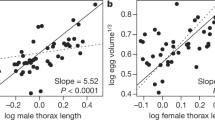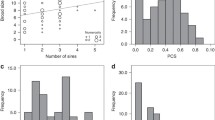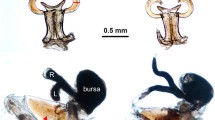Abstract
We currently classify sexual selection into pre- and post-copulatory components. In fact, pre-copulatory sexual selection (as envisaged by Darwin) represents the final stages of a cascade of events in the evolution of sexual strategy (the ‘sexual cascade’), each stage arising as a consequence of the stage before. The cascade begins with the evolution of recombination and syngamy in ancestral eukaryotic unicells. As zygote provisioning becomes an important component of zygote fitness (e.g. during the evolution of multicellularity), anisogamy arises by gamete competition (ancestral sperm competition) and/or gamete limitation in a broadcast spawning ancestor —these two selective forces act in concert. Recent models show more clearly the conditions under which the evolutionarily stable strategy (ESS) is for one sex (isogamy) or two sexes (anisogamy): gamete competition is always the greater selective force favouring anisogamy if an average of just one (or more) spawning competitor is present. The primordial sexual conflict probably involved a form of gamete conflict. With the evolution of two sexes, selection would operate to generate a unity sex ratio. The earliest multicellular animals would have been immobile or weakly mobile organisms with high gonad masses in both sexes, their only outlet for their reproductive effort being expenditure on gametes, with high sperm expenditure maintained by sperm competition and/or sperm limitation. Gradually, once weak mobility developed (for whatever initial reason), the selective pressures of gamete competition/limitation favours female targeting (males moving towards females to release sperm), leading to increased expenditure on female targeting and reduced expenditure on sperm. This process ultimately drives the evolution of copulation and internal fertilisation and greatly reduces sperm expenditure as pre-copulatory sexual selection then leads to the evolution of Darwinian sex roles and sexual conflict. There is, therefore, an evolutionary shift from sexual selection by sperm competition and sperm selection to sexual selection by an increasingly pre-copulatory component (the form of sexual selection that Darwin envisaged). Sperm competition nevertheless remains an important component of sexual selection, and a rich diversity in sperm allocation patterns is shaped by evolutionary sperm competition games. Different forms of pre-copulatory competition may also affect sperm allocation, sperm form and function.
Access provided by Autonomous University of Puebla. Download conference paper PDF
Similar content being viewed by others
We currently classify sexual selection into pre- and post-copulatory components. In fact, pre-copulatory sexual selection (as envisaged by Darwin) represents the final stages of a cascade of events in the evolution of sexual strategy (the ‘sexual cascade’), each stage arising as a consequence of the stage before. The cascade begins with the evolution of recombination and syngamy in ancestral eukaryotic unicells. As zygote provisioning becomes an important component of zygote fitness (e.g. during the evolution of multicellularity), anisogamy arises by gamete competition (ancestral sperm competition) and/or gamete limitation in a broadcast spawning ancestor—these two selective forces act in concert. Recent models show more clearly the conditions under which the evolutionarily stable strategy (ESS) is for one sex (isogamy) or two sexes (anisogamy): gamete competition is always the greater selective force favouring anisogamy if an average of just one (or more) spawning competitor is present. The primordial sexual conflict probably involved a form of gamete conflict. With the evolution of two sexes, selection would operate to generate a unity sex ratio. The earliest multicellular animals would have been immobile or weakly mobile organisms with high gonad masses in both sexes, their only outlet for their reproductive effort being expenditure on gametes, with high sperm expenditure maintained by sperm competition and/or sperm limitation. Gradually, once weak mobility developed (for whatever initial reason), the selective pressures of gamete competition/limitation favours female targeting (males moving towards females to release sperm), leading to increased expenditure on female targeting and reduced expenditure on sperm. This process ultimately drives the evolution of copulation and internal fertilisation and greatly reduces sperm expenditure as pre-copulatory sexual selection then leads to the evolution of Darwinian sex roles and sexual conflict. There is, therefore, an evolutionary shift from sexual selection by sperm competition and sperm selection to sexual selection by an increasingly pre-copulatory component (the form of sexual selection that Darwin envisaged). Sperm competition nevertheless remains an important component of sexual selection, and a rich diversity in sperm allocation patterns is shaped by evolutionary sperm competition games. Different forms of pre-copulatory competition may also affect sperm allocation, sperm form and function.
Author information
Authors and Affiliations
Corresponding author
Editor information
Editors and Affiliations
Rights and permissions
Copyright information
© 2021 Springer Nature Switzerland AG
About this paper
Cite this paper
Parker, G.A. (2021). The Sexual Cascade: Evolutionary Dynamics of Sperm Competition. In: Björndahl, L., Flanagan, J., Holmberg, R., Kvist, U. (eds) XIIIth International Symposium on Spermatology. Springer, Cham. https://doi.org/10.1007/978-3-030-66292-9_13
Download citation
DOI: https://doi.org/10.1007/978-3-030-66292-9_13
Published:
Publisher Name: Springer, Cham
Print ISBN: 978-3-030-66291-2
Online ISBN: 978-3-030-66292-9
eBook Packages: Biomedical and Life SciencesBiomedical and Life Sciences (R0)




